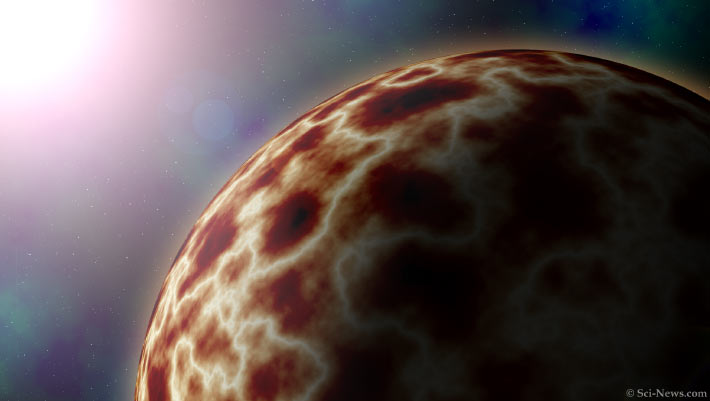Water is an important component of exoplanets, with its distribution, that is, whether at the surface or deep inside, fundamentally influencing the planetary properties. According to new research, for Earth-size planets and planets more massive than 6 times the mass of Earth, the majority of water resides deep in the cores of planets.
The majority of water can be stored deep within the exoplanet’s core and mantle, and not at the surface. Image credit: Sci.News.
“Most of the exoplanets known today are located close to their star,” said ETH Zurich’s Professor Caroline Dorn.
“This means they primarily comprise hot worlds of oceans of molten magma that have not yet cooled to form a solid mantle of silicate bedrock like the Earth.”
“Water dissolves very well in these magma oceans — unlike, for instance, carbon dioxide, which quickly outgasses and rises into the atmosphere.”
“The iron core is located beneath the molten mantle of silicates. So how is the water distributed between the silicates and the iron?”
“The iron core takes time to develop. A large share of the iron is initially contained in the hot magma soup in the form of droplets.”
“The water sequestered in this soup combines with these iron droplets and sinks with them to the core. The iron droplets behave like a lift that is conveyed downwards by the water.”
Until now this behavior had only been known to be the case for moderate pressures of the sort that also prevail in the Earth.
It was not known what happens in the case of larger planets with higher pressure interior conditions.
“This is one of the key results of our study,” Professor Dorn said.
“The larger the planet and the greater its mass, the more the water tends to go with the iron droplets and become integrated in the core.”
“Under certain circumstances, iron can absorb up to 70 times more water than silicates.”
“However, owing to the enormous pressure at the core, the water no longer takes the form of water molecules but is present in hydrogen and oxygen.”
This study was triggered by investigations of the Earth’s water content, which yielded a surprising result four years ago: the oceans on the Earth’s surface only contain a small fraction of our planet’s overall water.
The content of more than 80 of the Earth’s oceans could be hidden in its interior.
This is shown by simulations calculating how water behaves under conditions of the kind that prevailed when the Earth was young. Experiments and seismological measurements are accordingly compatible.
The new findings concerning the distribution of water in planets have dramatic consequences for the interpretation of astronomical observation data.
Using their telescopes in space and on the Earth, astronomers can under certain conditions measure the weight and size of an exoplanet.
They use these calculations to draw up mass-radius diagrams that permit conclusions to be drawn about the planet’s composition.
“If in doing so — as has been the case so far — the solubility and distribution of water are ignored, the volume of water can be dramatically underestimated by up to ten times,” Professor Dorn said.
“Planets are much more water-abundant than previously assumed.”
Water distribution is also important if we wish to understand how planets form and develop. The water that has sunk to the core remains trapped there forever.
However, the water dissolved in the magma ocean of the mantle can degas and rise to the surface during mantle cooling.
“So if we find water in a planet’s atmosphere, there is probably a great deal more in its interior,” Professor Dorn said.
Water is one of the preconditions for life to develop. There has long been speculation about the potential habitability of water-rich super-Earths.
Then calculations suggested that too much water could be hostile to life. The argument was that in these water worlds a layer of exotic high-pressure ice would prevent the exchange of vital substances at the interface between the ocean and the planet’s mantle.
The current study reaches a different conclusion: planets with deep water layers are likely to be a rare occurrence as most of the water on super-Earths is not located on the surface, as has been assumed until now, but is trapped within the core.
This leads the astronomers to assume that even planets with a relatively high water content could have the potential to develop Earth-like habitable conditions.
“Their study thus casts a new light on the potential existence of water-abundant worlds that could support life,” the authors said.
The study was published in the journal Nature Astronomy.
_____
H. Luo et al. The interior as the dominant water reservoir in super-Earths and sub-Neptunes. Nat Astron, published online August 20, 2024; doi: 10.1038/s41550-024-02347-z

